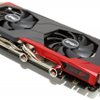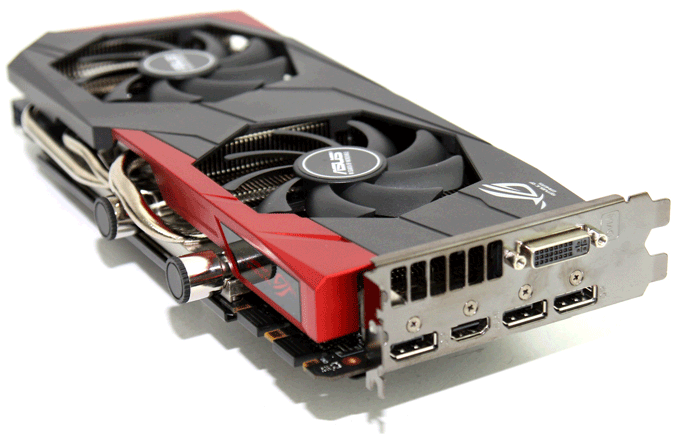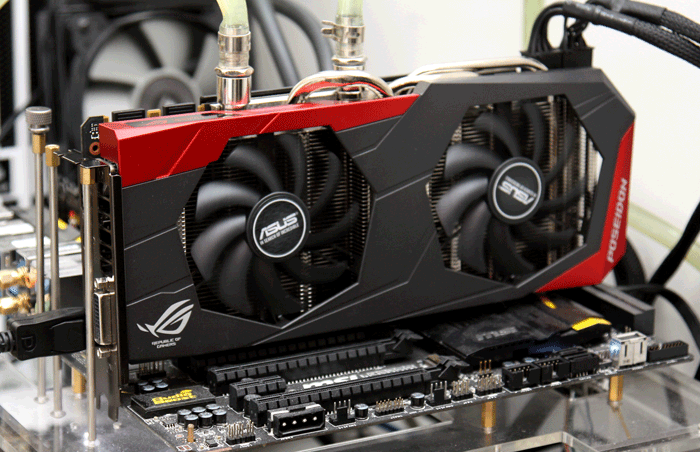Conclusion
Conclusion
So, as to why ASUS clocked the card this low with such impressive cooling we do not really know. I mean the potential is pretty good. With a little voltage tweak we reached give or take 1.50 GHz on the boost frequency thanks to liquid cooling. But perhaps therein lies the answer, with this product you can opt to NOT use liquid cooling and soley have the two fans and huge copper block perform as is. That will increase overall temps, sure. Still, if you are purchasing this product and do not liquid cool it, you'd be making a huge mistake as it would be shameful to now liquid cool the Poseidon. Performance then, well a card like the Poseidon is roughly at GeForce GTX Titan level performance straight out of the box, at a far better price. So yeah armed with 6GB of graphics memory and combined with the sheer rendering muscle this card has, you'll be future proof for a while. The one question that remains, and I will address this in each and every 980 Ti review, is simple; do you really need a card as beefy as the GTX 980 Ti really is? Well no Sir, not at all if you are playing games in the 1080P or 2560x1440 monitor resolution domain as the GTX 970 or 980 is sufficient. This card offers you to enable any quality settings you desire, and next to that DSR (super-sampling) is slowly becoming popular. With DSR you render at a higher resolution than sample it back to say 2560x1440, and that adds a level of extra image quality as pixels are calculated and rendered more accurately. We have an example of that in our benchmarks session, Shadow of Mordor which we rendered at a whopping Ultra HD and 5K and then output at 2560x1440. And yeah I know, it's all relative but these are options the true enthusiast crowd likes. Then there is Ultra HD, that brute resolution of 3840x2160 requires sheer raw horsepower to output its 4x Full HD resolution, and the GTX 980 Ti is one of two cards that can handle this resolution well with very decent image quality settings. So again, value for money wise you are way better off with a card like the GeForce GTX 970 or 980, make no mistake about that as there is no doubt. But this is enthusiast grade graphics hardware, and yeah it kinda rules. Plus you are a little more future proof with the nice 6GB frame-buffer of course. ASUS has a terrific GTX 980 Ti with the Poseidon at hand. The raw game rendering performance is sweet, the build quality top notch and the DirectCU H2O based cooling offers a very silent product, and heck it can overclock pretty terrifically as well. Combine that with the nice looks,three year warranty and that wicked cooler, and yeah, we have a winner here. Tweaking wise things remain very standard though the 1.5 GHz range is obviously nothing to complain about. Design wise you either hate or like the looks, nice to see is the included back-plate.
Thermals
Whether or not you choose Hybrid cooling with a liquid cooling loop is up to you. Just on air temps are will run towards 70~75 Degrees C with long term applied GPU stress, that said this product is called Poseidon, so you probably want to liquid cool it and see your temps drop to roughly 50 Degrees C under long-term full stress. Here again I have to say that the cooling performance will be based on your liquid cooling loop. But any average LCS will produce the temperatures you have seen here today. The difference on liquid cooling is pretty huge! You get optimal full coverage cooling on the VRM area, the hotspots and the GPU. All temps are in line, VRM at 50~60 Degrees C and the GPU is sitting at 45~50 Degrees C under full load. If we take that reference card at 80 degrees C in mind, and then drop to 45~50 Degrees C, then yeah, running 30~35 Degrees lower does amazing things. The cooler looks sturdy and bloke like as well, aesthetically it is a product that is easy on the eyes and will fit any dark and preferably red themed gaming PC quite well.
Cooling versus noise levels
We can’t complain, the Hybrid solution is just very silent and comparable to the normal DirectCU coolers. It is way more cooling compared to what this GPU really needs hence it allows ASUS to pull a trick or two with the Poseidon. Expect sound pressure values in the 36 to maybe 38 dBA range at max under load and warm circumstances. That's measured 75 CM away from the PC. At best you can slightly hear the card while using it heavily. For those that require sheer silence like yours truly, this is the way to go. But here again, your LCS kit will make the real noise as that is the cooling exhaust part, not this card. We have not heard any coil noise or detected whine noises.
Power Consumption
Much like the GM200 Maxwell GPU harbored in Titan X, this GTX 980 Ti is rated as having a 250~260 Watt TDP, our measurements pass that number by a good degree as we measured roughly 275 Watt. It likely is due to the factory overclock, which requires additional voltage. We remain comfortable advising a 650 Watts power supply if you do not go crazy overclocking wise. If you go with 2-way SLI, a 950 Watts power supply is recommended. Remember when purchasing a PSU, aim to double up in Wattage as your PSU is most efficient when it is under 50% load. Here again keep in mind we measure peak power consumption, the average power consumption is a good notch lower depending on GPU utilization. Also, if you plan to overclock the CPU/memory and / or GPU with added voltage, please do purchase a power supply with enough reserve. People often underestimate it, but if you tweak all three aforementioned variables, you can easily add 200 Watts to your peak power consumption budget.
Game Performance
We can't be any clearer about it, all ranges from 1080P to Ultra HD are very playable for the GeForce GTX 980 Ti. Up-to WQHD (2560x1440) this card seems to be a true sweet-spot, however it is really capable of rendering games in that whopper of a resolution Ultra HD as well. You'll be in the 40 FPS on average domain with decent settings and the latest titles mostly, and that's ok. This much game rending horse-power versus the nice 6GB graphics memory helps you in Ultra HD, hefty complex anti-aliasing modes, DSR and of course the latest gaming titles. And that makes this the second viable single GPU solution that allows you to game properly in Ultra HD with some very nice eye candy enabled with a single GPU. Drivers wise we can't complain at all, we did not stumble into any issues. And with a single GPU there's no micro-stuttering to fight off. Performance wise, really there's not one game that won't run seriously good at the very best image quality settings. You must do gaming with a nice 30" monitor of course, at 2560x1440/1600 or Ultra HD.
Overclocking
The boost modes can be configured with temperature targets relative to maximum power draw and your GPU Core frequency offsets. Saying that; I realize it sounds complicated but you'll have your things balanced out quite fast as these products are easy to tweak. Our GPU sample could take a ~1270 MHz base clock, add to that the dynamic boost clock and you'll see your games rendering in the 1400 to 1500 MHz domain. The memory you'll be able to get close to roughly 8 GHz effective. This card uses Hynix memory btw. Don't push memory too far though, and we certainly do not recommend adding voltage to that memory. The overclock potential is good, but just that. We expected a little higher being on LCS.
Concluding
Personally I am a big fan of the Poseidon series as it is just such a sturdy and quality build and once you connect the card to a liquid cooling loop you have this hugely impressive GPU cooled in the 50 Degrees C range. As stated, our overclocking results where a little average, but 1.5 GHz is still a very decent range to be in. Tweaking varies per production batch and even per GPU, your results may be much better, but also can be worse then ours. The performance is overall faster than a GeForce GTX Titan X, yet pricing is much better at MSRP is $725 USD marker. In the end this product will offer you a AAA gaming experience in any monitor resolution, as even Ultra HD now becomes a viable resolution for single GPU setups. The card does so while keeping itself at nice temperatures. Compared to the GeForce GTX 980 Ti at 2560x1440 you can expect an increase of up-to say 25% performance (over the reference GeForce GTX 980 Ti) and overclocked you can add another 10%. We adore the ASUS GeForce GTX 980 Ti Poseidon for what it really is, a super fast performing product with nice aesthetics, excellent noise levels and intense low cooling performance. The model as tested today hovers at roughly 750 EURO at the moment of writing, but availability is low up-to the point of no availability. Yyou will have a hard time finding it. The graphics card itself, well it is a beast of a card for any WHQD to Ultra HD PC gaming rig anno 2015. You flick on all finest image quality settings and get yourself submerged into a quality gaming experience. The ASUS ROG GeForce GTX 980 Ti Poseidon Platinum is a terrific piece of technology. Silky smooth and fluid framerates is what you'll get thanks to the tremendous horsepower at hand combined with low noise levels and temperatures, especially once you start using liquid cooling as an option or your preferred alternative. This product comes recommended by Guru3D.com and we are awarding the product a Top Pick award as it really is that, a top pick.
- Sign up to receive a notice when we publish a new article
- Or go back to Guru3D's front page



